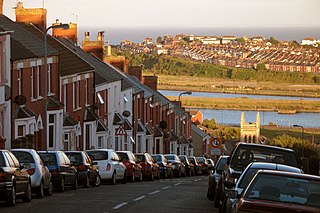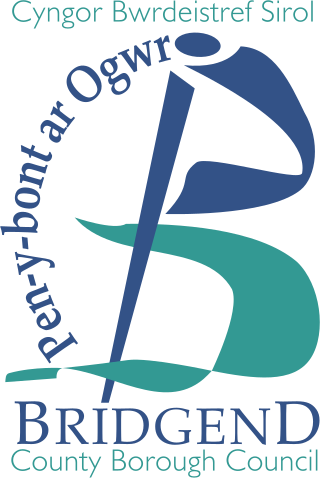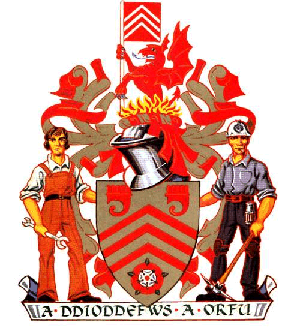
The Vale of Glamorgan, locally referred to as The Vale, is a county borough in the south-east of Wales. It borders Bridgend County Borough to the west, Cardiff to the east, Rhondda Cynon Taf to the north, and the Bristol Channel to the south. With an economy based largely on agriculture and chemicals, it is the southernmost unitary authority in Wales. Attractions include Barry Island Pleasure Park, the Barry Tourist Railway, Medieval wall paintings in St Cadoc's Church, Llancarfan, Porthkerry Park, St Donat's Castle, Cosmeston Lakes Country Park and Cosmeston Medieval Village. The largest town is Barry. Other towns include Penarth, Llantwit Major, and Cowbridge. There are many villages in the county borough.

South Glamorgan is a preserved county of Wales.

Mid Glamorgan is a preserved county of Wales. From 1974 until 1996 it was also an administrative county with a county council.

Cathays railway station is a station on the Merthyr and Rhondda lines in the Cathays district of Cardiff, Wales. It is 1+1⁄4 miles (2 km) north of Cardiff Central.

Barry is a town and community in the Vale of Glamorgan, Wales. It is on the north coast of the Bristol Channel approximately 9 miles (14 km) south-southwest of Cardiff. Barry is a seaside resort, with attractions including several beaches and the resurrected Barry Island Pleasure Park. According to Office for National Statistics 2021 estimate data, the population of Barry was 56,605.

Susan Linda Essex is a British politician who served in the Welsh Assembly Government as Minister for the Environment from 2000 to 2003 and Minister for Finance, Local Government and Public Services from 2003 to 2007. A member of the Labour Party, she was Leader of Cardiff City Council from 1994 until its abolition in 1996 and Assembly Member (AM) for Cardiff North from 1999 until her retirement in 2007.

Cardiff Council, formally the County Council of the City and County of Cardiff is the governing body for Cardiff, one of the principal areas of Wales. The principal area and its council were established in 1996 to replace the previous Cardiff City Council which had been a lower-tier authority within South Glamorgan. Cardiff Council consists of 79 councillors, representing 28 electoral wards.

Bridgend County Borough Council is the governing body for Bridgend County Borough, one of the principal areas of Wales.

Cardiff City Council was the local government district authority that administered the city of Cardiff, capital of Wales, from 1974 until 1996. The district council replaced the pre-1974 county borough council. It was succeeded in 1996 by Cardiff Council.
John Edward "Jack" Brooks, Baron Brooks of Tremorfa DL was a Welsh politician and boxing functionary.
Russell Vivian Goodway is a Welsh Labour Party councillor for Ely, Cardiff; and the former Lord Mayor of Cardiff and former CEO of Cardiff Chamber of Commerce. He was Britain's youngest council leader when he led South Glamorgan County Council in 1992.
Politics of Cardiff refers to the political representation of the city of Cardiff, capital of Wales. Cardiff is represented politically at a local, Wales and United Kingdom level and previously at the European level.

The Glamorgan Archives, previously known as the Glamorgan Record Office, is a county record office and repository based in Leckwith, Cardiff, Wales. It holds records for the whole of the historic county of Glamorgan but primarily for the post-1974 counties of Mid and South Glamorgan.
The centre of Cardiff, the capital of Wales, is relatively flat and is bounded by hills on the outskirts to the east, north and west. Its geographic features were influential in its development as the world's largest coal port, most notably its proximity and easy access to the coal fields of the south Wales valleys.

Mid Glamorgan County Council was the upper-tier authority for the Welsh county of Mid Glamorgan between its creation in 1974 and its abolition in 1996.

Cardiff County Borough Council, known as Cardiff City Council after Cardiff achieved city status in 1905, was the elected local authority that administered the town and county borough of Cardiff, Glamorgan, Wales between 1889 and 1974. The county borough council was replaced in 1974 by a district council, covering part of South Glamorgan and also known as Cardiff City Council.

Central was the name of an original electoral ward in the centre of the county borough and, from 1905, city of Cardiff, Wales. It elected representatives to the Cardiff County Borough Council and, from 1974, South Glamorgan County Council. The ward ceased to exist in 1996.
The Vale of Glamorgan Borough Council was the local authority for the Vale of Glamorgan in South Glamorgan, Wales, created in 1974 and reconstituted in 1996 as the Vale of Glamorgan Council unitary authority. It was a second tier district authority, with South Glamorgan County Council providing county-level services to the area.
The 1971 Cardiff City Council election was held on Thursday 13 May 1971 to elect councillors to Cardiff City Council in Cardiff, Glamorgan, Wales. It took place on the same day as several other county borough elections in Wales and England.
Emyr Currie-Jones CBE (1917–2008) was a local Labour Party politician in Cardiff, Wales. He was Chairman of South Glamorgan County Council and known for his role in introducing Welsh-language education in Cardiff. He has been described as "an outstanding example of a local councillor who steered Welsh-medium education through many a political storm."














